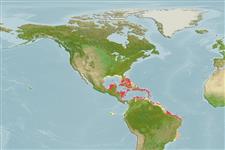>
Atheriniformes (Silversides) >
Atherinidae (Silversides) > Atherinomorinae
Etymology: Atherinomorus: Greek, atherina, the Greek name for the eperlane + Greek, moros = silly, stupid (Ref. 45335).
More on authors: Müller & Troschel.
Environment: milieu / climate zone / depth range / distribution range
Ökologie
seewasser; süßwasser; brackwasser riff-verbunden. Subtropical
Western Atlantic: southern Florida (USA), Bahamas, and Yucatan, Mexico to Brazil. Southeast Pacific: known only from Tumaco, Colombia (Ref. 9273).
Length at first maturity / Size / Gewicht / Alter
Maturity: Lm 6.0 range ? - ? cm
Max length : 10.0 cm TL Männchen/unbestimmt; (Ref. 7251); common length : 7.5 cm TL Männchen/unbestimmt; (Ref. 5217)
Rückenflossenstacheln (insgesamt) : 10 - 11; Rückenflossenweichstrahlen (insgesamt) : 8 - 10; Afterflossenweichstrahlen: 9 - 13. Head wider than body (Ref. 26938).
Found over soft bottoms as well as in coral reefs (Ref. 5217). Often in large schools (Ref. 5521). Feeds on zooplankton (Ref. 5217).
Life cycle and mating behavior
Geschlechtsreife | Fortpflanzung | Ablaichen | Eier | Fecundity | Larven
Lavenberg, R.J. and M. Chernoff, 1995. Atherinidae. Pejerreyes. p. 889-901. In W. Fischer, F. Krupp, W. Schneider, C. Sommer, K.E. Carpenter and V. Niem (eds.) Guia FAO para Identification de Especies para lo Fines de la Pesca. Pacifico Centro-Oriental. 3 Vols. FAO, Rome. (Ref. 9273)
IUCN Rote Liste Status (Ref. 130435: Version 2024-1)
Bedrohung für Menschen
Harmless
Nutzung durch Menschen
Fischereien: weniger kommerziell; Köder: usually
Tools
Zusatzinformationen
Download XML
Internet Quellen
Estimates based on models
Preferred temperature (Ref.
123201): 26.3 - 28.2, mean 27.5 °C (based on 695 cells).
Phylogenetic diversity index (Ref.
82804): PD
50 = 0.5005 [Uniqueness, from 0.5 = low to 2.0 = high].
Bayesian length-weight: a=0.00724 (0.00437 - 0.01201), b=3.22 (3.08 - 3.36), in cm total length, based on LWR estimates for this species & (Sub)family-body (Ref.
93245).
Trophic level (Ref.
69278): 3.3 ±0.3 se; based on diet studies.
Widerstandsfähigkeit (Ref.
120179): hoch, Verdopplung der Population dauert weniger als 15 Monate. (Preliminary K or Fecundity.).
Fishing Vulnerability (Ref.
59153): Low vulnerability (10 of 100).
Nutrients (Ref.
124155): Calcium = 74.6 [30.4, 207.3] mg/100g; Iron = 0.72 [0.36, 1.36] mg/100g; Protein = 20.3 [18.0, 22.6] %; Omega3 = 0.229 [0.097, 0.578] g/100g; Selenium = 9.05 [3.59, 22.93] μg/100g; VitaminA = 106 [31, 377] μg/100g; Zinc = 1.51 [0.88, 2.41] mg/100g (wet weight);
